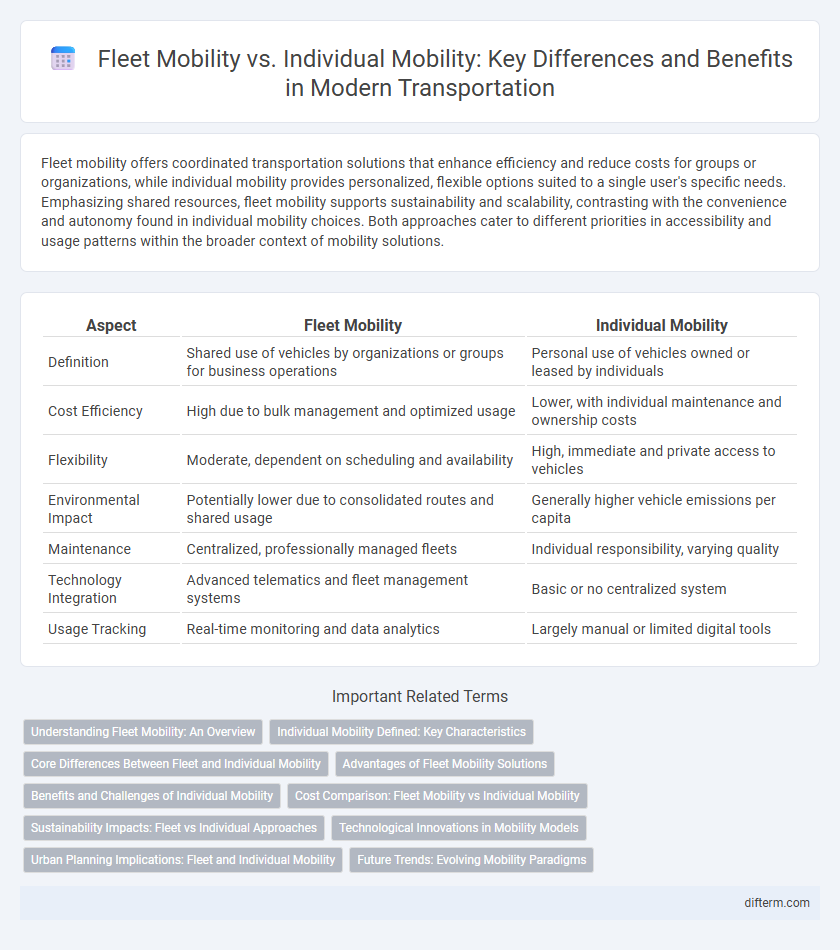Fleet mobility offers coordinated transportation solutions that enhance efficiency and reduce costs for groups or organizations, while individual mobility provides personalized, flexible options suited to a single user's specific needs. Emphasizing shared resources, fleet mobility supports sustainability and scalability, contrasting with the convenience and autonomy found in individual mobility choices. Both approaches cater to different priorities in accessibility and usage patterns within the broader context of mobility solutions.
Table of Comparison
| Aspect | Fleet Mobility | Individual Mobility |
|---|---|---|
| Definition | Shared use of vehicles by organizations or groups for business operations | Personal use of vehicles owned or leased by individuals |
| Cost Efficiency | High due to bulk management and optimized usage | Lower, with individual maintenance and ownership costs |
| Flexibility | Moderate, dependent on scheduling and availability | High, immediate and private access to vehicles |
| Environmental Impact | Potentially lower due to consolidated routes and shared usage | Generally higher vehicle emissions per capita |
| Maintenance | Centralized, professionally managed fleets | Individual responsibility, varying quality |
| Technology Integration | Advanced telematics and fleet management systems | Basic or no centralized system |
| Usage Tracking | Real-time monitoring and data analytics | Largely manual or limited digital tools |
Understanding Fleet Mobility: An Overview
Fleet mobility encompasses coordinated transportation solutions that optimize vehicle usage, reduce operational costs, and enhance efficiency for businesses managing multiple vehicles. Unlike individual mobility, which centers on personal transportation needs, fleet mobility leverages telematics, route optimization, and real-time data to streamline vehicle deployment and maintenance. This approach results in lower emissions, improved resource allocation, and better scalability for urban and commercial mobility challenges.
Individual Mobility Defined: Key Characteristics
Individual mobility centers on personal transportation options that emphasize autonomy, flexibility, and convenience. Key characteristics include the use of private vehicles, bicycles, or micro-mobility devices, enabling tailored travel schedules and routes. This contrasts with fleet mobility, which relies on shared vehicles and coordinated logistics for efficient group transport.
Core Differences Between Fleet and Individual Mobility
Fleet mobility emphasizes collective transportation solutions managed by organizations, optimizing routes and vehicle usage to reduce costs and environmental impact. Individual mobility prioritizes personal convenience and flexibility, with users selecting modes based on real-time needs and preferences. Core differences lie in the scale of operation, control mechanisms, and the integration of technology for efficient resource allocation.
Advantages of Fleet Mobility Solutions
Fleet mobility solutions offer enhanced cost-efficiency through bulk vehicle acquisition, maintenance, and fuel management, reducing expenses compared to individual ownership. Centralized fleet management systems optimize routes and vehicle usage, increasing productivity and minimizing downtime. These solutions also improve sustainability by enabling the integration of electric or hybrid vehicles and facilitating consolidated transportation, lowering overall carbon emissions.
Benefits and Challenges of Individual Mobility
Individual mobility offers unparalleled flexibility and convenience, allowing users to choose personalized routes and schedules that optimally suit their needs. However, challenges include increased congestion, higher environmental impact, and greater infrastructure demands compared to fleet mobility solutions. Despite these drawbacks, individual mobility supports autonomy and spontaneous travel, driving innovation in vehicle technology and urban planning.
Cost Comparison: Fleet Mobility vs Individual Mobility
Fleet mobility significantly reduces per-user costs by leveraging bulk purchasing, optimized route planning, and shared maintenance expenses, which individual mobility cannot match due to dispersed and personalized usage patterns. Individual mobility incurs higher costs related to vehicle ownership, insurance, parking, and maintenance, making it less cost-efficient compared to fleets. Companies adopting fleet solutions benefit from economies of scale and lower total cost of ownership, enhancing overall operational cost efficiency.
Sustainability Impacts: Fleet vs Individual Approaches
Fleet mobility solutions significantly reduce carbon emissions by optimizing route efficiency and maximizing vehicle utilization compared to individual mobility, which often leads to higher per capita energy consumption. Shared electric fleets promote sustainability through reduced traffic congestion, lower air pollution, and decreased demand for parking infrastructure. Transitioning to fleet-based models supports urban sustainability goals by enabling scalable adoption of renewable energy and advanced telematics for continuous environmental impact monitoring.
Technological Innovations in Mobility Models
Technological innovations in mobility models have transformed fleet mobility through advanced telematics, AI-powered route optimization, and electric vehicle integration, enhancing efficiency and sustainability for commercial fleets. Individual mobility benefits from shared mobility platforms, autonomous vehicles, and real-time data analytics that enable personalized travel experiences and reduce reliance on private cars. These innovations drive a shift toward smarter, greener transportation ecosystems by leveraging connectivity, automation, and data-driven decision-making.
Urban Planning Implications: Fleet and Individual Mobility
Urban planning must balance the infrastructure needs of fleet mobility, such as shared vehicles and micro-mobility services, with those of individual mobility, including private cars and bicycles. Integrating dedicated lanes, optimized parking solutions, and charging stations for fleet vehicles supports sustainable urban transport and reduces congestion. Prioritizing multimodal connectivity enhances accessibility and promotes a shift toward shared, eco-friendly mobility options within densely populated cities.
Future Trends: Evolving Mobility Paradigms
Fleet mobility leverages shared, autonomous electric vehicles integrated with smart city infrastructure to reduce congestion and emissions, enhancing urban efficiency. Individual mobility is shifting toward personalized electric micromobility devices equipped with AI-powered route optimization and seamless multimodal connectivity. Future trends emphasize the fusion of fleet and individual solutions through mobility-as-a-service platforms driven by big data analytics and IoT, transforming urban transportation landscapes.
fleet mobility vs individual mobility Infographic

 difterm.com
difterm.com